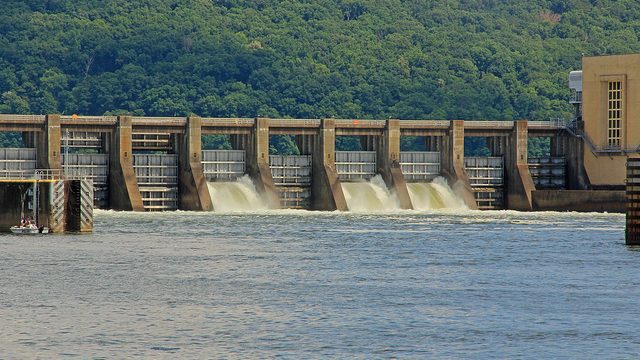A Student Perspective: 2018 Global Change and Food-Energy-Water Symposium

Written by Stephanie Courtney, a Master of Science student at Auburn University, this post presents a summary of a symposium organized by Karen McNeal, University Consortium PI at Auburn University. The symposium brought together Auburn researchers, key USGS scientists, and representatives of local and regional agencies to increase internal and external visibility of ongoing research activities, enhance local networks, and strengthen collaborations among researchers, agencies, and local decision makers.
Just a few short months ago, I thought very differently about who a “stakeholder” was, had probably never heard the word “co-production,” and only nebulously dreamed of “actionable” science. As a new Master’s student at Auburn University, a new Southeast Climate Science Center consortium institution, I now have refreshed ideas and goals surrounding each of these concepts. On February 9th, members of the Auburn, AL, community had the opportunity to learn about them too.
The 2018 Auburn Global Change and Food-Energy-Water Nexus Symposium was held February 9 in the Auburn CASIC building, home of the Auburn Water Resources Center, among many other active research initiatives. The symposium featured short lightning talks from several members of our community, a discussion-based working lunch, and an illuminating talk from Dr. Ryan Boyles, Acting USGS Director of the Southeast Climate Science Center.
Ryan Boyles provided an overview of the objectives, past successes, and goals of the Southeast CSC, and of the Climate Science Centers broadly. The audience of faculty, graduate students, and a handful of professionals from local water resource offices were intent to learn how the Centers do science differently and how they each may participate. Truly, the past work of the Climate Science Centers is impressive and expansive, and the future goals of the centers are no different.
Climate change problems themselves are expansive, of course, which is the reason our meeting had attendees from five different colleges of Auburn University. Having so many people working on these problems in different departments and using different strategies is crucial to solving the problems of climate change, but it also means that groups of researchers with shared goals may not get to interact and collaborate regularly. Reaching across university departments and reaching even further to connect with researchers from non-university offices and agencies makes our research better. Further, broadening our research communities to include stakeholders and managers is crucial to meeting the co-production objectives of the Climate Science Centers.
Knowing this, and concurrent with the mission of the Climate Science Centers, one of the major goals of our meeting was to start building a research community around climate change and FEW issues. Attendees told us they really valued the 3-minute lightning talk format and loved to learn what other researchers in the Auburn area were doing, work that they might never have learned about otherwise. The broad scope of research projects shared by lightning speakers and in Ryan’s examples, stimulated a variety of energetic conversations that I had the pleasure of listening in on. Further, I think being reminded of the broad scope of projects possible by the lightning talks while thinking in the framework of the directly applied research projects of the Climate Science Centers stimulates our creative and strategic thinking. We are necessarily reminded that there is so much to do, but managers are often the folks charged with deciding what must happen right now.
The small scale and relative informality of our symposium encouraged participation from graduate students as well – in fact, I technically gave my very first talk, though I used only ~2 of my 3 minutes. The dozen or so of us grad students were charged over lunch with discussing what we thought the SE CSC could do for us. Basically, we came up with no bad ideas. As graduate students, we don’t know what we don’t know – every idea one of us had, the rest of us were excited about too. At this stage of education, we are expected to narrow in focus, and we therefore lose track of other frameworks and methods used across and outside of academia. The problem, of course, is that we need to work with and become those people across and outside of academia for the rest of our careers. Similarly, learning the Climate Science Center process of co-produced actionable science, often not emphasized in traditional academia, is novel and energizing. So from more research-sharing, to policy history, to decision-making strategies, we, the graduate students, concluded that we were ready for all of it. Faculty formed other groups around project themes including: Coastal resiliency; Multi-scale conservation planning; decision making under uncertainty; communication, capacity building, and evaluation; and future climate, hydrology, land-use, ecohydrology and species conservation. All faculty groups were tasked to discuss about what their recommendations were for Auburn to engage more with the topic; what we can do to help build the community at Auburn, the SE CSC, and Innovations at the Nexus of Food-Energy-Water; and who would be a good speaker to bring to Auburn’s campus. Large-group reporting-out occurred at the end of the session.
The most widely-shared sentiment of the Auburn Global Change and FEW Nexus Symposium was that we didn’t want these conversations to fizzle out. Attendees from every department were eager to share papers, projects, seminars, and, most importantly, ideas, in whatever forms possible. Researchers working on climate change problems know well that cooperation and communication are what make strong adaptation decisions. A successful Southeast Climate Science Center will depend on coordination across consortium institutions, and this coordination will grow stronger as we continue to build our local research communities – though I don’t think this is what Ryan is talking about when he mentions downscaling.
- Categories:
